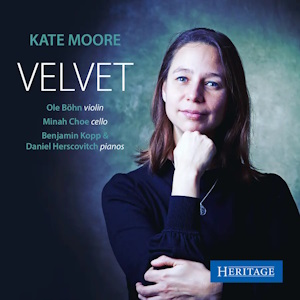
Kate Moore (b. 1979)
Velvet
The Body is an Ear for two pianos (2011)
Dies Irae for violin and piano (2015)
Velvet for cello and piano (2010)
Way of the Dead for violin and piano (2017)
Zomer for piano (2006)
Heather for violin and piano (2013)
Lucidity: Eye of Hands (2018)
Benjamin Kopp (piano)
Daniel Herscovitch (piano II)
Ole Böhn (violin)
Minah Choe (cello)
rec. 2023, Verbrugghen Hall, University of Sydney, Australia
Heritage HTGCD137 [79]
The main reason for looking at this disc when it appeared on our monthly list of recordings to review was because I thought it might include an entry or two for my piano trio discography, but as you can see from the information above, it doesn’t. Nevertheless, I did give the samples a listen, and found enough to like to request it, when it was likely to have gone review-less otherwise.
Kate Moore is an Australian composer, based in The Netherlands. Her CV has three academic qualifications, a number of fellowships, including one from Tanglewood, and a deal of recognition in her adopted country, including one in 2022 for her contribution to the performing arts.
One part of the informative booklet notes is contributed by one of the pianists on the recording, Daniel Herscovitch, and he mentions stylistic links between Moore’s music with that of Philip Glass and Steve Reich. Moore rejects the minimalism tag, but I think that this is simply a matter of the composer wanting to assert her individuality, because if you listen just to the opening minute of the first piece, The Body is an Ear, it is impossible not to think of Philip Glass, particularly earlier in his career. The melodic lines for the two pianos weave in and out of each other, and with only gradual changes over time – if that isn’t minimalism, I don’t know what is. At over eleven minutes, it is not something that I feel you listen to intently for every single second, but rather it creates a hypnotic atmosphere that you sink into (that said, right near the end, there is a burst of loud dissonance to jolt you).
Dies Irae was inspired by hearing the melody from the Requiem Mass being played elsewhere in the building at Tanglewood. The violin takes the melody into the highest registers, while the piano quietly ripples away. Now I could go onto to describe each of the other five pieces, but what I would say would only differ slightly from what I have already written (in the best traditions of minimalism). The tempos, rhythms and dynamics change little from one work to the next. Well, that is my response as a listener anyway; the booklet notes, in part contributed by the composer, state that “each deploys a different compositional technique”.
The music is very soothing, and any given section is perfectly enjoyable, but if you attempt to listen to the entire disc straight through, I suspect you will not make it to the end without having switched to concentrate on something else. I would be being facetious to say that you shouldn’t drive or use machinery while listening to this recording, but I think you will understand what I mean. The performances, such as it is possible to make a judgement without comparison, sound ideal for the music, and the sound quality is good.
David Barker
Buying this recording via a link below generates revenue for MWI, which helps the site remain free



















